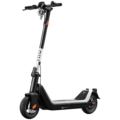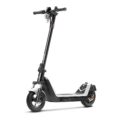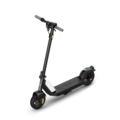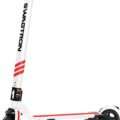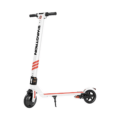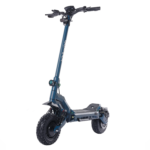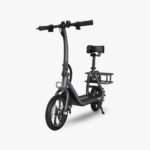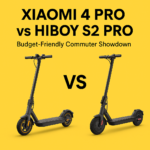- Home
- Scooters
- Electric Scooters
- NIU KQi 200P
NIU KQi 200P
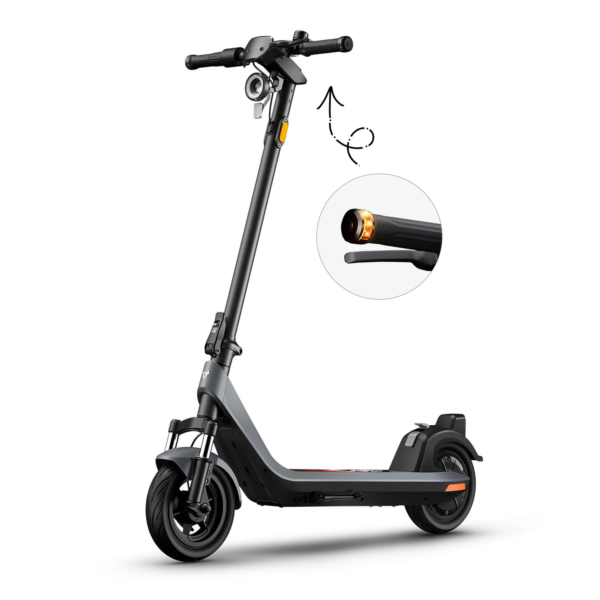

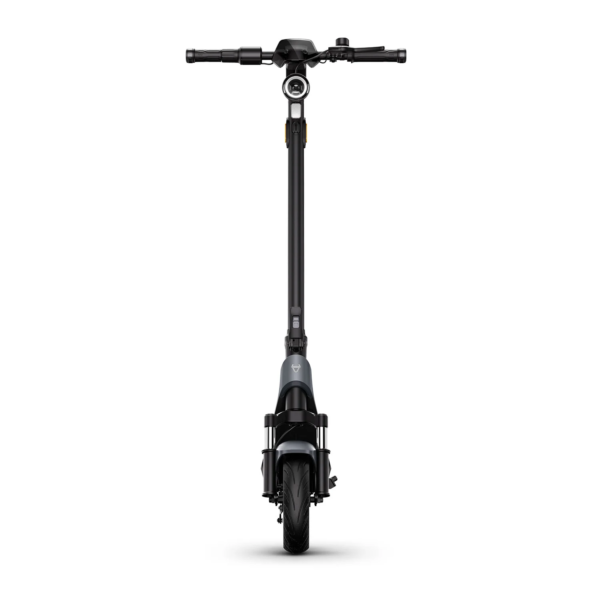
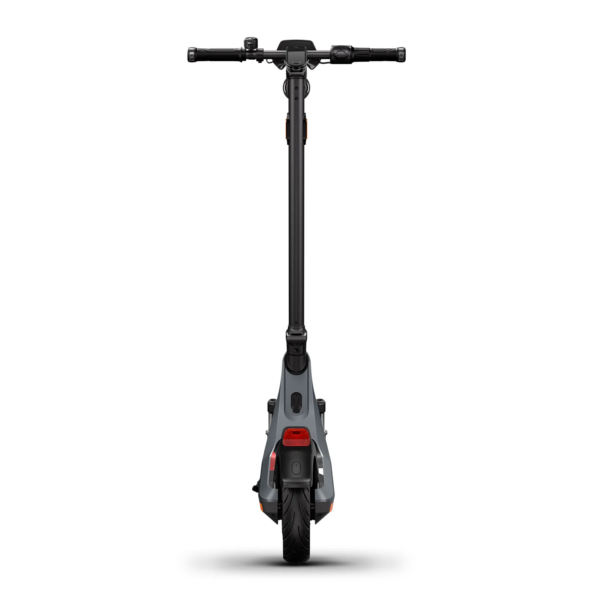
- Battery Range: 33.6 mi (≈54 km)
- Top Speed: 19.5 mph (≈31 km/h)
- Motor Power: Rated 350 W
- Weight Capacity: 265 lb (120 kg)
- Charging Time: 6–7 hours
- Scooter Weight & Portability: 43.4 lb (19.7 kg)
PROS
- Front dual-tube suspension + 10″ tubeless tires = unusually smooth ride for the class
- Sensible power with rear-wheel drive and predictable throttle
- App adds charge-limit, regen tuning, and useful ride stats
- IPX5 weather protection with halo headlight and turn signals
- Compact fold and solid frame that stays quiet over time
CONS
- Handlebar doesn’t fold (that’s the 200F), so folded width is 21.3″
- Top speed capped under 20 mph won’t satisfy speed-seekers
- No rear mechanical brake; relies on regen paired with a front drum

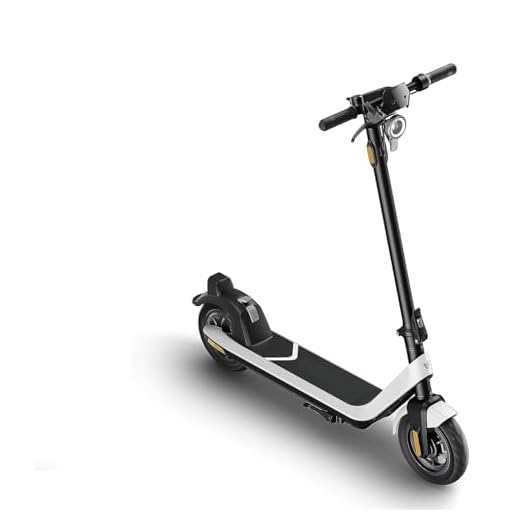
Introduction: A New Baseline for Practical, Comfortable Commuting
The NIU KQi 200P Specifications set a fresh baseline for everyday riders who want more than a bare-bones commuter but less than a hefty performance scooter. Instead of chasing top speed, NIU focuses on balance: a rated 350 W motor tuned for smooth delivery, a 365 Wh battery configured for dependable range, and front dual-tube suspension that actually softens jolts without adding much weight. As a result, the 200P lands squarely in the sweet spot for city travel. It feels stable at pace, confident over rough patches, and notably refined for its class.
Moreover, NIU bakes in the features riders now expect: 10-inch tubeless tires for grip and comfort, a front drum + rear regenerative braking setup for controlled stops, and an IPX5 water-resistance rating for splashy rides. The brand’s app adds smart tweaks like charge-limit, adjustable regen, and acceleration modes. Together, these elements produce a scooter that doesn’t just look composed on paper—it behaves sensibly where it matters: sidewalks, bike lanes, and cross-town streets.
This deep-dive explores power, range, comfort, safety, portability, features, durability, and value. Along the way, you’ll see how the 200P differs from the sibling 200F (folding handlebar model) and how it stacks up against rivals in the same price band. Most importantly, you’ll understand whether this is the right scooter for your daily life.
Motor & Throttle Response: Calm, Predictable Power for City Pace
First, let’s address the motor. On spec sheets, a 350 W rating may look modest. However, NIU pairs that rating with thoughtful tuning and 700 W peak output. Consequently, the 200P pulls away with reassuring smoothness rather than jerking forward. That controlled start matters in real traffic. It lets you roll off the line without wobble, feed in a bit more throttle, and then settle at 19.5 mph without stress.
Additionally, the rear-wheel drive layout helps traction. Many entry scooters drive the front wheel and, as a result, sometimes spin or slip on sandy corners or damp paint lines. The 200P pushes from the back, so you feel planted. Furthermore, the wide deck and tubeless rubber keep the chassis steady when you accelerate across patchy asphalt. Because of that grip, you can focus more on lane position and less on managing micro-slides.
Hill behavior tells a similar story. While steep climbs inevitably slow a commuter motor, the 200P still tackles typical city grades with composure. You won’t sprint uphill, but you also won’t stall or overheat on normal inclines. For dense urban neighborhoods with rolling terrain, that balance feels well judged. Meanwhile, the adjustable acceleration mode in the app gives you a softer “Chill” setting for slick conditions and a livelier feel for dry mornings.
In short, the 200P’s power profile favors confidence over flash. It chooses stable drive and predictable torque over bragging rights, which is exactly what most commuters need Monday through Friday.
Top Speed & Flow: Why 19.5 mph Hits the Practical Ceiling
Although speed temptations are real, commuter reality argues for restraint. With the NIU KQi 200P Specifications, the 19.5 mph cap keeps you aligned with many shared lanes, mixed-use paths, and urban limits. More importantly, it allows the chassis to feel composed. Because velocity escalates crash energy exponentially, keeping speed under 20 mph supports consistent stopping distance and reduces rider fatigue.
Moreover, the combination of smooth throttle mapping and transitional regen assists your pacing. For example, as you roll off the throttle toward a light, the scooter naturally scrubs a bit of speed. Therefore, you reach intersections with less drama and fewer hard brake squeezes. In turn, you conserve battery and keep your ride unhurried yet efficient.
On empty stretches, you can sit at top speed without a sense of strain. The motor doesn’t howl, the stem remains quiet, and the deck stays calm. Consequently, you arrive fresher, which matters if you ride daily and still need to work a full shift after your commute.
Battery & Real-World Range: Consistency Over Hype
Because range anxiety ruins commuting, NIU equips the 200P with a 365 Wh pack and 14-layer battery management. The headline 33.6 mi is an optimistic lab figure, yet the takeaway is consistency. In everyday use, riders running mixed modes and stop-and-go traffic can expect a dependable window well above typical round-trip urban distances.
Additionally, 6–7 hours to recharge fits natural routines. You plug in after dinner, set a charge limit in the app if you want to extend cell longevity, and then forget about it. As a result, the scooter is ready each morning, and your battery ages gracefully over months. Furthermore, the regen level setting lets you choose how aggressively the motor harvests energy. On rolling routes, a higher setting yields slightly better endurance and gives a smoother, engine-brake feel.
Cold weather always trims range, yet the 200P’s pack—with reasonable capacity and conservative tuning—handles seasonal swings better than many budget scoots. Likewise, the app’s ride stats make your consumption visible. Consequently, you learn your personal efficiency curve and plan charging days accordingly. For most commuters, that knowledge alone dissolves the last bit of range stress.
Tires, Suspension & Ride Comfort: Small Scooter, Big Calm
Comfort isn’t just about luxury. It directly affects control, fatigue, and safety. Here, the 200P brings two standout components: 10.0 × 2.3 in tubeless tires and dual-tube front suspension. The tubeless design resists pinch flats and holds shape over curbs or expansion joints. Meanwhile, the front shock absorbs the sharp edges that otherwise rattle stems loose on rigid scooters.
Consequently, your hands don’t buzz, and your feet don’t tingle after longer rides. Although the shock stroke is modest, it’s enough to take the sting out of patched asphalt. Moreover, the tires’ broader 2.3-inch profile increases the contact patch. As a result, cornering at neighborhood speeds feels planted, even when you roll across pollen dust or painted lines.
Ergonomics help too. The deck gives you real stance options, so you can ride parallel or adopt a slight diagonal, then swap feet mid-ride to relax your hips. The stem height is accommodating for average and taller riders, and the 21.3-inch handlebar width (on the 200P) keeps steering quick without feeling twitchy. Because everything sits in harmony, the scooter encourages a relaxed, attentive posture that reduces fatigue over time.
Braking, Lights & Safety Systems: Predictable Stops, High Visibility
Reliable braking prevents close calls from becoming collisions. The 200P combines a front drum with rear electronic regen so you get progressive feel and short, stable stops. In practice, you squeeze the lever and sense gentle deceleration first; then the drum adds bite as speed drops. Hence, you avoid nose-dive drama, and you maintain steering control when stopping in a hurry.
Furthermore, NIU’s lighting package punches above its class. The always-on halo increases daytime conspicuity, while the main headlight reaches far enough for slow street riding after dusk. At the rear, the taillight brightens under braking, and side reflectors add a passive layer of visibility. On top of that, the KQi 200 series includes turn signals, which help you communicate intentions in traffic and on paths. Therefore, motorists and cyclists can read your moves sooner, which reduces conflict points.
Finally, the IPX5 rating protects the scooter against splashes. You should still avoid deep puddles, yet light rain commutes feel low stress. Combined with the de-cluttered cable routing and robust stem latch, the overall safety system inspires confidence day in and day out.
Portability, Folding & Storage: Everyday Practical, Not Featherlight
Although the KQi 200P isn’t the lightest, it lands at a manageable 43.4 lb. As a result, occasional stair carries, trunk loading, and doorway pivots are very doable. The two-step fold is quick, and the 45.3 × 21.3 × 21.5 in folded footprint fits hatchbacks and small storage corners.
However, the 200P’s handlebars do not fold inward (that’s the 200F’s party trick). Consequently, the folded width is the bar width—21.3 in—which is still compact enough for hall closets and office corners. If you need the slimmest possible stow, the 200F shrinks to 6.9 in width when folded; otherwise, the 200P’s simplicity means fewer moving parts and, arguably, better long-term rigidity at the bar.
Because the frame uses automotive-grade steel, the scooter feels solid when you lift it. The stem doesn’t flex awkwardly, and the deck doesn’t creak. Therefore, you can carry it confidently without babying the hinge or worrying about latch play developing after a few months.
App, Modes & Smart Tweaks: Small Settings, Big Difference
Modern commuting benefits from light customization. NIU’s app delivers exactly that—without turning your scooter into a science project. You can switch among E-Save, Sport, Dynamic, and Pedestrian modes, then fine-tune acceleration, regen intensity, and even set a charge limit to preserve long-term battery health.
Moreover, the app shows ride stats that go beyond a basic odometer. You’ll see distance, pacing, and energy trends, which help you refine your routes. For instance, if a back-street shortcut saves two minutes but burns disproportionate battery due to hills and stops, you’ll spot that pattern and adjust. Consequently, you squeeze more usefulness out of every charge.
On the scooter, the LED dashboard stays legible in bright sun and low light. The interface is minimal on purpose: speed, battery, and mode, with obvious icons. Hence, you keep eyes up and mind on traffic rather than fiddling with screens. Over time, those small design choices keep your rides easy and your attention where it belongs—on the road.
Daily Use Scenarios: How It Performs Where You Ride
Short downtown hops. If your route is three miles each way, the 200P feels ideal. You leave home, slip past jammed side streets, and glide through greens without sweat or noise. Because acceleration is smooth, you merge with bike traffic without jolting.
Mixed-surface neighborhoods. Many cities stitch together older asphalt, patchwork repairs, and the occasional brick lane. Here, the dual-tube front shock and tubeless tires earn their keep. You still feel the surface, yet the edge is softened. Consequently, your hands and calves stay fresh, even after spontaneous errands.
Commutes with transit. The 200P’s folded footprint drops into ride-share trunks and commuter rail vestibules. While the handlebar width remains full, it still moves through train doors easily. Additionally, the weight is balanced around the stem, so one-hand lifts for a few seconds aren’t punishing.
After-hours returns. When you leave the office late, the lighting package keeps you seen. As you approach intersections, the halo announces your presence sooner, and the headlight makes potholes visible at appropriate speeds. Meanwhile, regen assists gentle slowing well before you touch the lever.
In every case, the overarching theme holds: the 200P favors calm competence. It helps you move with the city instead of fighting it.
Durability & Maintenance: Designed to Stay Tight and Quiet
Commuter scooters live rough lives. They endure curb drops, quick folds, and hallway bumps. The 200P’s steel frame, tidy cable runs, and drum-plus-regen brakes reduce the parts that typically drift out of tune. Because the front brake is enclosed, it shrugs off grit that would glaze pads on open discs. Furthermore, regen steals some workload from the drum, so mechanical wear falls over time.
As for the rolling bits, the tubeless setup means fewer pinch flats and easier puncture fixes. You add sealant if you like, check pressures weekly, and ride. Additionally, the front shock preserves the stem latch by filtering sharp hits that would otherwise hammer hinge hardware. Consequently, the scooter stays quiet. No chorus of creaks after a month. No mystery rattles from the folding block.
Maintenance routines stay light: tire pressure, fastener checks on a monthly cadence, and an occasional app update when NIU pushes an improvement. Because the app also lets you cap the charge to 80–90%, you can slow battery aging with one tap—an advantage that pays off after hundreds of cycles.
200P vs. 200F: Which One Suits You?
Although both share the same drive system, battery, suspension, and brakes, they diverge on handlebars and storage. The 200F owns the trick folding bars, collapsing width to 6.9 in for ultra-tight spaces and frequent transit hops. It also carries wider bars when unfolded (23.9 in), which some riders prefer for steering leverage.
Conversely, the 200P keeps a fixed 21.3 in bar. As a result, it folds faster (no bar hinge to fiddle with), avoids one extra moving part, and still fits most trunks and corners. If you commute by train daily and space is tight, the 200F’s narrow folded width is compelling. If you mainly store at home or in a regular office nook, the 200P’s simplicity and rigidity can be the better long-term bet.
Since performance and range are identical, pick by storage constraints and bar feel. Riders who like the most stable steering might lean 200F; riders who want fewer mechanisms to maintain will appreciate the 200P.
Comparisons Beyond the 200 Series: Where It Sits in the Market
Against other mid-range commuters, the 200P brings three distinct advantages. First, front suspension at this weight and price is still uncommon; many competitors rely on tires alone. Second, NIU’s app features—notably charge-limit and regen tuning—feel more polished than the “checkbox” apps on budget brands. Third, the IPX5 rating and tidy wiring make wet-day use less nerve-wracking.
On the other hand, some rivals push higher top speeds or boast double the battery. Yet they often weigh significantly more, cost notably more, or skip suspension entirely. For riders who truly need 25+ mph, the 200P won’t be enough; however, most city riders will see the mix of comfort, stability, and features as the smarter daily choice.
As for NIU’s own line, the KQi3 Pro offers more range and slightly stronger hill pace, but it’s heavier and lacks the 200’s front shock. Meanwhile, the KQi Air X wins for pure carry-weight but trades away suspension and costs much more. Therefore, when you filter by price, comfort, and practical commuting range, the 200P lands in a very tight Goldilocks zone.
Ideal Rider Profiles & Use Cases
City commuter who values comfort. You ride 4–8 miles a day, prefer calm acceleration, and want fewer jolts. The 200P’s shock + tubeless combo fits perfectly.
Student with mixed storage. You’ll keep it under a desk or in a dorm corner and occasionally haul it in a trunk. The 200P’s footprint works; if storage is ultra-tight, consider the 200F instead.
Beginner upgrading from a budget scoot. You want better brakes, real tires, and an app that helps you learn your usage. The 200P’s stability and tuning feel immediately more mature without being intimidating.
All-weather practicalist. You’ll ride in drizzle and need solid lighting and water protection. IPX5 and the halo headlight reduce the stress of marginal weather days.
Long-Term Value & Ownership Costs
Because the 200P targets sensible performance, it avoids burning through pads and batteries. The regen takes load off the drum, the tubeless tires reduce flats, and the app helps keep the pack healthy. Consequently, consumables last longer, and big components stay tight. Over a year of commuting, that translates into fewer shop visits and more predictable costs.
Furthermore, NIU’s two-year coverage on major parts outpaces many value competitors. That timeframe spans a huge portion of the early life curve when defects reveal themselves. If anything crops up, you’re not stranded. Meanwhile, over-the-air firmware keeps the scooter current, which extends useful life beyond what a static, non-connected scooter can offer.
Final Verdict
The NIU KQi 200P Specifications point to a commuter that values stability, comfort, and sensible tech. With a smooth 350 W motor (peaking at 700 W), a consistent 365 Wh battery, dual-tube front suspension, 10-inch tubeless tires, and IPX5 weather protection, it delivers daily calm without bloating weight or price.
Yes, it caps speed under 20 mph. Yes, the bars don’t fold like the 200F’s. However, those choices fit its mission: a sturdy, easy-to-live-with scooter that rides smoothly, stores easily, and keeps working week after week. If your goal is to arrive relaxed, on time, and without drama, the KQi 200P belongs at the top of your shortlist.
Specifications
General
| Model The Model specifies the exact version or name of the scooter. It helps identify its unique design, features, and specifications within the manufacturer’s product line. Knowing the model makes it easier to compare options, find compatible accessories, or look up support information. | KQi 200P |
| Brand The Brand identifies the manufacturer or company that designs and produces the scooter. A trusted brand is a sign of quality, reliability, and good customer support. Well-known brands often have higher standards for safety, performance, and after-sales service, giving you more confidence in your purchase. | NIU |
| Release Date The Release Date indicates when the scooter model was officially launched on the market. This helps you know how current the design, technology, and features are. A newer release date often means updated components, improved performance, and the latest safety or smart features. | 01 January 2025 |
| Recommended Age Recommended Age indicates the minimum age range that the scooter is designed for, based on safety, size, and ease of use. Following the recommended age helps ensure that riders can handle the scooter’s speed, weight, and controls comfortably and safely. Always check local laws and use protective gear, especially for younger riders. | 14+ |
Performance & Power
| Motor Power (Wattage) What it means: The motor power, measured in watts (W), shows how strong the scooter’s electric motor is. Why it matters: Higher wattage usually means better acceleration, more torque, and improved performance on hills or rough terrain. For example, a 250W motor is good for flat city roads and light riders, while a 500W or 1000W motor provides more power for faster speeds or climbing steep inclines. | Rated 350 W, Peak 700 W |
| Top Speed The Top Speed indicates the maximum speed that the scooter can reach under optimal conditions. It’s usually measured on level ground with a fully charged battery and an average rider weight. A higher top speed allows you to travel longer distances faster, but always ensure you ride within legal speed limits and your personal comfort zone for safety. | 19.5 mph (≈31 km/h) |
| Battery Capacity Battery Capacity refers to the total amount of energy the scooter’s battery can store, usually measured in ampere-hours (Ah) or watt-hours (Wh). A higher battery capacity means you can ride longer distances on a single charge, reducing the need for frequent recharging. Keep in mind that actual range can vary depending on rider weight, terrain, speed, and weather conditions. | 365 Wh (48 V, 7.8 Ah) |
| Estimated Range per Charge The Estimated Range per Charge indicates the average distance the scooter can travel on a single full battery charge. This range is calculated under optimal conditions, such as flat terrain, moderate speed, and average rider weight. Real-world range may vary depending on riding style, terrain, weather, and load. A longer range means fewer recharges and greater freedom for longer trips. | up to 33.6 mi (≈54 km) |
| Hill Climb Ability Hill Climb Ability describes the maximum incline or slope that the scooter can handle while maintaining stable performance. It’s typically expressed as a percentage or in degrees. A higher hill climb rating means the scooter can tackle steeper hills without losing too much speed or power. Actual climbing performance may vary based on rider weight, battery charge, and terrain conditions. | up to 20% grade |
| Drive System The Drive System refers to how power from the motor is delivered to the wheels. Electric scooters typically use either a hub motor (directly integrated into the wheel) or a chain/belt drive system. A high-quality drive system ensures smooth acceleration, efficient power transfer, and low maintenance. The choice of drive system affects performance, noise level, and overall ride experience. | Rear-wheel drive |
Charging & Electrical
| Charging Time Charging Time indicates how long it takes to fully recharge the scooter’s battery from empty to 100% using the standard charger provided. Faster charging means less downtime and more time on the road. Actual charging time may vary slightly depending on battery capacity, charger output, and environmental conditions. | 6–7 hours |
| Battery Type Battery Type refers to the specific technology used in the scooter’s battery, which affects performance, lifespan, weight, and charging time. Most modern electric scooters use high-quality lithium-ion (Li-ion) batteries because they offer a good balance of energy density, durability, and low maintenance. A reliable battery type ensures consistent power delivery and longer riding ranges. | Lithium-ion pack with NIU Smart BMS (14-layer protection) |
| Removable Battery A Removable Battery means the battery pack can be easily detached from the scooter for convenient charging and replacement. This feature allows you to charge the battery separately, swap it with a spare for extended range, or securely store it indoors in extreme weather. Removable batteries add flexibility and make it easier to keep your scooter powered up wherever you are. | No |
| Regenerative Braking Regenerative Braking is an energy-saving feature that converts some of the energy normally lost during braking back into battery power. When you slow down or brake, the motor works in reverse to generate electricity, which helps extend the scooter’s range and improves overall efficiency. This system also reduces wear on traditional brake components, leading to lower maintenance over time. | Yes |
| Lighting Lighting refers to the built-in front and rear lights that enhance visibility and safety when riding in low-light conditions or at night. Good lighting helps you see the road ahead and ensures that other road users can see you. Many scooters include LED headlights, taillights, and sometimes brake lights or side reflectors for added safety and compliance with local traffic regulations. | Halo headlight, tail/brake light, side reflectors; turn signals on KQi 200 series |
Build & Dimensions
| Scooter Weight Scooter Weight refers to the total weight of the scooter when fully assembled, including the battery. This affects how easy it is to carry, lift, and store the scooter when not in use. A lighter scooter is more portable and convenient for commuting, especially if you need to carry it upstairs or onto public transport. Keep in mind that a sturdy frame and quality components may add to the weight but also contribute to better durability and ride stability. | 43.4 lb (19.7 kg) |
| Maximum Rider Weight Maximum Rider Weight indicates the highest rider weight that the scooter is designed to safely support while maintaining optimal performance and stability. Staying within this limit helps ensure reliable acceleration, braking, and climbing ability, and it protects the frame, suspension, and motor from excessive strain. Exceeding the recommended limit may reduce performance and increase wear on components. | 265 lb (120 kg) |
| Deck Size Deck Size refers to the dimensions of the scooter’s standing platform. A wider and longer deck provides more foot space, allowing you to stand comfortably and adjust your stance while riding. A well-sized deck improves balance and stability, especially on longer rides or at higher speeds. Compact decks, on the other hand, help keep the scooter lightweight and portable. | ~19.5 × ~5.5 in (approx., rider-measured class value) |
| Handlebar Height Handlebar Height refers to the distance from the deck to the handlebars, which affects your riding posture and comfort. An appropriate handlebar height helps you maintain good balance, reduces strain on your back and arms, and makes steering more comfortable. Some scooters have adjustable handlebars to fit riders of different heights, while others have a fixed height for a streamlined design. | ~48.7 in overall height |
| Folding Mechanism The Folding Mechanism describes how easily and securely the scooter can be folded for carrying and storage. A well-designed folding system lets you quickly collapse the scooter into a compact size, making it convenient to transport on public transit, store under a desk, or fit into a car trunk. Look for sturdy latches and safety locks to ensure the scooter stays firmly in place when folded or unfolded. | Yes |
| Dimensions Folded Dimensions indicate the size of the scooter when it’s fully folded. This measurement shows how much space the scooter will take up when stored or carried, making it easier to check if it will fit in your car trunk, under a desk, or in a closet. Compact folded dimensions are ideal for commuters who need to bring their scooter on public transport or store it in tight spaces. | 45.3 × 21.3 × 21.5 in (1151 × 541 × 546 mm) |
| Material Material refers to the primary construction materials used for the scooter’s frame and key components. High-quality materials like aircraft-grade aluminum, reinforced steel, or durable composites provide strength, stability, and a lighter overall weight. A sturdy material ensures the scooter can handle daily wear and tear while maintaining safety and performance. | Automotive-grade steel frame with concealed wiring |
Safety & Control
| Brake Type(s) Brake Type(s) describe the braking systems the scooter uses to help you slow down or stop safely. Common brake types include mechanical brakes (like drum or disc brakes), electronic brakes, and foot brakes. Many scooters combine multiple braking systems for added safety and shorter stopping distances. The type and quality of brakes affect your control, especially when riding at higher speeds or on slopes. | Front drum brake + rear e-brake (regen) |
| Suspension Suspension refers to the system that absorbs shocks and vibrations while riding, providing a smoother and more comfortable ride over uneven or rough surfaces. Scooters may have front suspension, rear suspension, or dual suspension for better shock absorption and stability. Good suspension helps reduce rider fatigue and improves control, especially when riding on bumpy roads or off-road paths. | Front dual-tube spring (≈32 mm stroke) |
| Tire Type Tire Type refers to the kind of tires the scooter uses, which directly affects ride comfort, traction, and maintenance. Common types include solid (airless) tires, pneumatic (air-filled) tires, or hybrid options. Pneumatic tires offer better shock absorption and a smoother ride on rough surfaces, while solid tires are puncture-proof and require less upkeep. The right tire type helps ensure safe handling and a comfortable ride in different conditions. | Tubeless pneumatic |
| Tire Size Tire Size indicates the diameter and width of the scooter’s tires, which affect ride comfort, stability, and how well the scooter handles different terrains. Larger tires generally offer better shock absorption and a smoother ride over bumps and rough surfaces, while smaller tires keep the scooter lighter and more portable. Choosing the right tire size helps ensure a balance between agility and comfort. | 10.0 × 2.3 in (254 × 58 mm), front & rear |
| Kickstand The Kickstand is a built-in stand that allows you to park your scooter upright when it’s not in use. A sturdy kickstand keeps the scooter stable and prevents it from tipping over, protecting it from scratches and damage. It also makes storing and accessing your scooter more convenient, whether you’re at home, work, or on the go. | Yes |
| Water Resistance Rating Water Resistance Rating indicates how well the scooter is protected against water and moisture, usually shown as an IP (Ingress Protection) rating. This rating helps you understand whether the scooter can handle light rain, splashes, or wet roads without damage. While most scooters are not fully waterproof, a good water resistance rating adds peace of mind when riding in changing weather conditions. Always avoid deep puddles or submerging the scooter to protect its electrical components. | IPX5 |
Features & Extras
| Display/Console The Display (or Console) shows important real-time information about your ride, helping you monitor your scooter’s status at a glance. Typical displays show speed, battery level, distance traveled, and riding mode. Some models also include additional features like Bluetooth connectivity, app integration, or backlighting for better visibility at night. A clear and easy-to-read display enhances safety and convenience on every trip. | LED dashboard (speed, battery, mode) |
| Ride Modes Ride Modes refer to the different speed and power settings you can choose to match your riding style or road conditions. Common modes include eco for maximum range and energy efficiency, standard for everyday balance, and sport or turbo for higher speed and stronger acceleration. Switching between ride modes allows you to customize performance, conserve battery, and ride safely in various environments. | E-Save, Sport, Dynamic, Pedestrian |
| Smart App Connectivity Smart App Connectivity lets you pair your scooter with a dedicated mobile app via Bluetooth. Using the app, you can monitor real-time ride stats like speed, battery level, and range, adjust settings such as ride modes or cruise control, lock the scooter for added security, and sometimes receive firmware updates. This feature adds convenience and allows you to personalize your riding experience right from your smartphone. | Yes |
| Anti-Theft System The Anti-Theft System helps protect your scooter from unauthorized use or theft. This feature can include built-in alarms, electronic motor locks, GPS tracking, or remote locking through a mobile app. A good anti-theft system provides peace of mind when parking your scooter in public spaces, adding an extra layer of security to safeguard your investment. | App-based lock / smart unlock |
| Cruise Control Cruise Control allows you to maintain a steady speed without continuously holding the throttle. This feature makes longer rides more comfortable by reducing hand fatigue and providing a smoother, more relaxed riding experience — especially on flat, open roads or bike lanes. For safety, cruise control can usually be easily activated or deactivated while riding. | Yes |
| Accessories Included Accessories Included lists the additional items that come with the scooter to enhance your riding experience and convenience. Common accessories may include a charger, kickstand, bell, lights, phone holder, or carrying strap. These extras add value by making your scooter safer, easier to use, and ready to ride straight out of the box. | Charger, manual, basic tools (standard pack) |
Warranty & Compliance
| Warranty Period The Warranty Period indicates how long the manufacturer guarantees the scooter against defects in materials and workmanship under normal use. A good warranty provides peace of mind, showing the brand’s confidence in its product quality. Always check what parts are covered, such as the frame, battery, and motor, and follow the maintenance guidelines to keep your warranty valid. | 2 years (major components) |
| Certifications Certifications confirm that the scooter meets specific safety, quality, and environmental standards set by recognized organizations or regulatory bodies. Common certifications may include CE, RoHS, UL, or other local compliance marks, depending on your region. These certifications ensure that the scooter is manufactured to high standards and is safe and legal to use in your country. | Manufacturer water ingress rating stated as IPX5 |
Price Comparison




